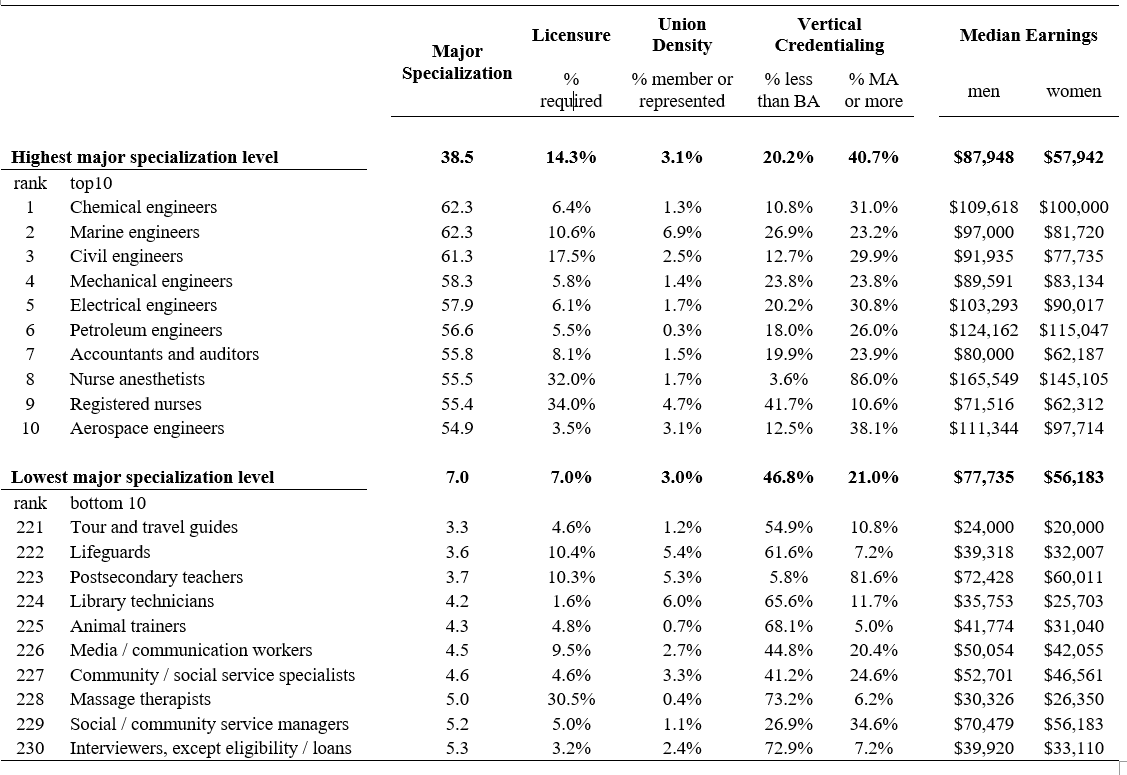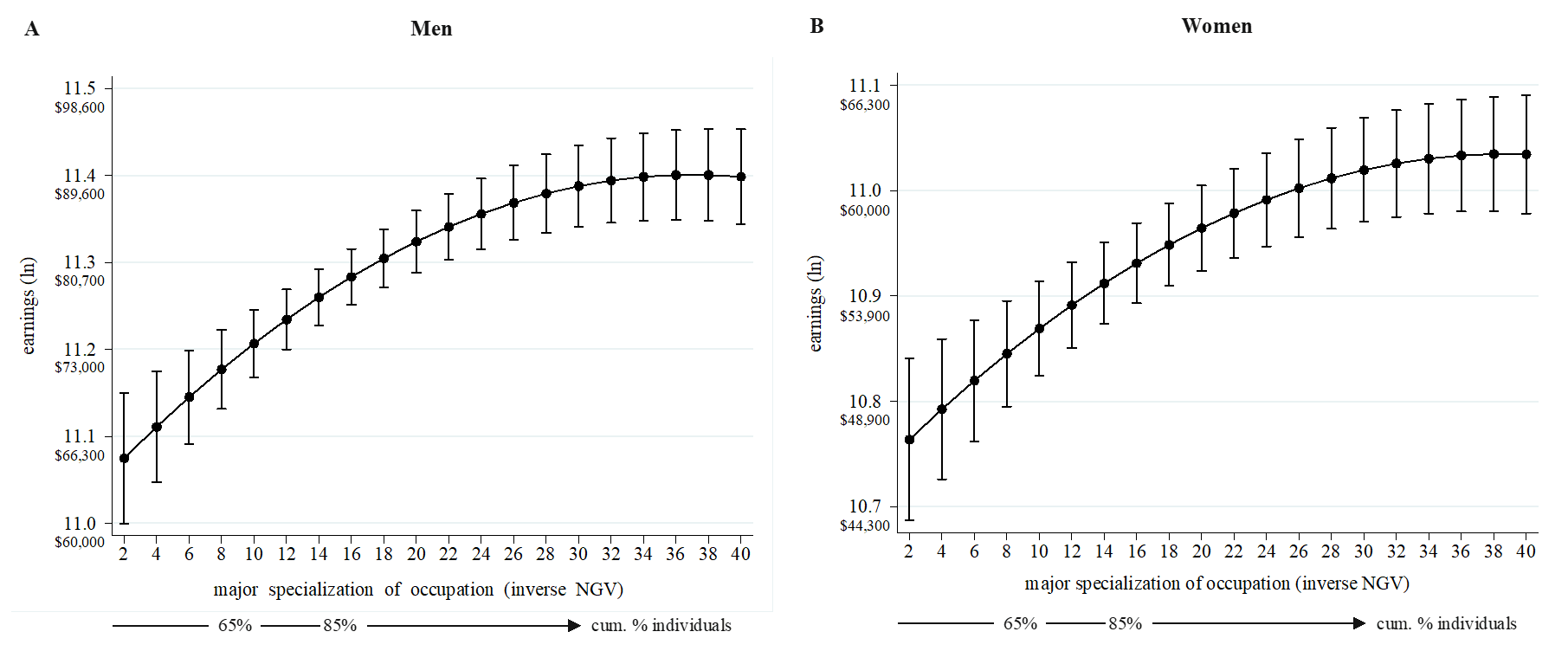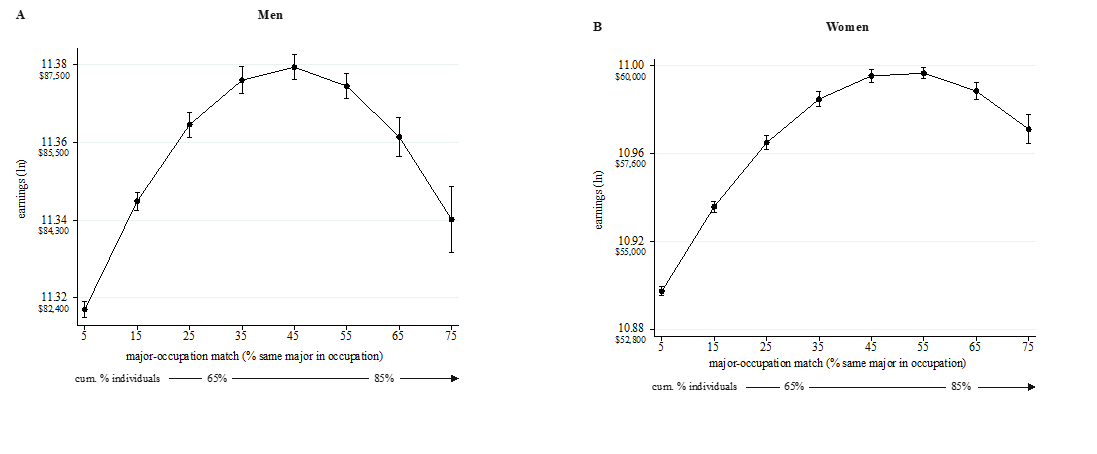Issue, No.28 (December 2023)
The Role of College Majors in Earnings Inequality among College Graduates
The college degree earnings premium, typically measured as the gap between the average earnings of bachelor’s degree graduates and high school graduates, has grown steadily over recent decades and is often attributed to ever-growing human capital demands in the service sector and high-tech industries (Autor 2014). Educational stratification appears to be a driver of earnings inequality in high-income countries (Lemieux 2007) because college degrees, in particular, help individuals enter jobs that are rewarded with increasingly higher salaries and wages compared to the rest of the economy. However, the monetary benefits of college education are unlikely to be uniform. Our paper concentrates on the relationship between undergraduate programs and earnings inequality among college graduates in the United States. We consider two perspectives to understand the role of undergraduate majors in earnings inequality in the highest-educated segment of the economy using recent data from the American Community Survey. First, we focus on the distribution of college majors across occupations, asking whether the concentration of college majors within an occupation is associated with occupational-level earnings. Second, we examine the importance of “matching” an individual’s own college major with the commonly held major in the occupation: Is it true that mismatching yields a substantial earnings penalty at the individual level?
College major closure
First, sociological research has shown that earnings variation between occupations is not only a function of the occupation’s “skill” (i.e., human capital), but also of the capacity of occupational incumbents to channel demand, restrict the labor supply, and signal quality of service (Weeden 2002). Various institutionalized strategies help restrict the number of possible competitors in an occupation, such as licensing and formal educational credentials. These requirements “guarantee” quality-of-service offered by incumbents, but at the same time offer these same incumbents a tool to control labor supply of the occupation. Together with collective bargaining (unions), licensing and credentialing are critical “closure devices” that are associated with higher occupation-level rewards, over and above the human capital value of the services provided. Scholars have found evidence for “closure effects” in various high-income countries, such as the United States, United Kingdom, Germany, and Norway (Bol & Weeden 2015; Bol & Drange 2017). In this study, we ask a straightforward question with regard to the higher-educated segments of the labor market – where most workers hold a bachelor’s degree: Should the college major be considered an occupational closure device that boosts earnings? In other words, if college majors are activated to control access to an occupation (as a “closure device”), a higher density of college majors within an occupation should be associated with higher occupation-level earnings, over and above the human capital of the workers within the occupation.
To answer this first question, we select from the 5-year 2013-2017 American Community Survey microdata all individuals employed in occupations with at least 25% of its incumbents holding a bachelor’s degree. This selection includes 230 occupations representing our population of interest: the higher-educated segment of the labor market (about 1.4 million respondents). These microdata contain relevant individual-level covariates of earnings, such as socio-demographics, region, graduate school attainment, and of course undergraduate major (37 fields). To effectively measure stratifiers of occupation-level earnings, we fit a “hierarchical linear model” containing the aforementioned individual-level drivers of earnings variation and occupation-level predictors. Inspired by earlier work on closure effects on earnings levels, we construct occupation-level variables for union density, share of graduate degrees, and licensure, as well as its concentration of selective college degrees, gender distribution, and occupation-level skills (drawn from O*NET – a series of surveys on average skill requirements of micro-occupations).
We conceptualize “major specialization” of every micro-occupation as the key indicator of college major density: the hypothesized occupational closure device. The major specialization variable is the normalized qualitative variance of college major as calculated by occupation. We can calculate for each occupation the probability that two randomly paired cases (i.e., workers within the same occupation) hold different college majors: normalized generalized variance (NGV). Subsequently, we take the inverse of occupations’ NGV, so that a value of 0 reflects perfect differentiation (i.e., all workers hold a different major) and the maximum (100) reflects perfect “specialization” (i.e., all workers hold the same major). In practice, our measure of occupations’ major specialization ranges between 3 and 62. Table 1 presents the ten most and ten least major-specialized occupations, alongside averages of other occupation-level closure devices and the mean earnings for men and women. It is difficult to draw conclusions based on these descriptive statistics, so we employ a hierarchical linear model with these occupation-level variables and individual-level variables.
Table 1. Occupations’ Closure Indicators and Earnings by Major Specialization Tier

This allows us to answer our key question: How effective is the college major density – or “major specialization” – as an occupational closure device? We find that, after controlling for individuals’ socio-demographics and established occupational closure devices (i.e., licensure, unionization, and vertical educational credentialing), an occupation’s major specialization is positively and strongly associated with occupational earnings. As shown in Figure 1, the effect size of the college major density variable is substantial given the large point estimate jumps compared to the relatively small increments on the inverse NGV scale. The strength of the association between occupational major specialization and earnings appears to be similar for men and women, though women earn less on average. Yes, US college majors form barriers for occupational entry and this process creates an earnings boost enjoyed by all incumbents, over and above the occupation’s skill-level payoffs and the characteristics of workers within the occupation.
Figure 1. Marginal Effects of Major Specialization of Occupations (Occupation Random Intercepts)

College major matching
Second, we turn to the role of college majors in explaining earnings variation at the individual level. Previous research has shown that college graduates’ earnings vary substantially by college major (Monaghan & Jang 2017). Again, we consider the heterogeneity within this relationship by examining the context in which college graduates are employed. The dominant explanation for college major “pay off” variation is that different college majors carry different types or levels of human capital. For example, assuming there’s a consistently high demand for technical services in the economy, we might expect workers who hold a so-called “STEM major” to earn more than, say, sociology majors (assuming there’s less aggregate demand for sociological analysis). But what if the STEM graduate becomes a high school teacher? Or what if the sociology major becomes a tax agent? Do they earn more or less than their college major-occupation “matched” counterparts? Using data from the United States, Germany, and France, researchers found that being employed in a common destination to others who hold the same college major is associated with an earnings advantage (Bol et al. 2019). Conversely, not being in a “matched occupation” leads to an earnings disadvantage for the college graduate.
One innovative analytical strategy proposed in our study is to examine the “major-occupation” match organically rather than using dichotomous description of the graduate’s employment context (i.e., matched vs. not matched, as used in earlier work). We construct a continuous measure of major-occupation match by calculating for each individual the percentage of workers in the same occupation who hold the same undergraduate major. This empirically driven procedure is called a “realized matches” approach in the economics of education. While this matching percentage is quite high for college graduates in occupations such as nursing, where almost everyone holds the same nursing degree as the respondent, the major-occupation match practically ranges between 0% and 72%.
We then regress earnings on the individual-level major-occupation, while accounting for a range of individual-level controls and occupation-fixed effects. Figure 2 shows the estimates from this model. We find a significant positive association between major matching within occupations and earnings. Concentrating on the linear component of the model, a 10-percent increase in the share of workers holding the same college major within the occupation as the individual is associated with 3.6 percent (men) to 4.8 percent (women) higher earnings. These effect sizes translate to a couple of thousand dollars annually. Hence, yes, a stronger major-occupation match is beneficial to the college graduate, but the relative advantages (or disadvantages) remain small. Furthermore, the relationship is non-linear: very strong major-occupation matches do not yield extraordinarily higher pay.
Figure 2. Marginal Effects of Major-Occupation Match on Earnings (with Occupation Fixed-Effects)

Implications
Undergraduate majors explain a substantial share of earnings variation among higher-educated individuals in the workforce. Economists often conceptualize these college major “effects” as payoffs from human capital investments, such that the variation in college major earnings payoffs more or less reflects the “demand” for skills obtained in higher education programs and applied in particular occupation (Altonji et al. 2012). We do not disagree with this perspective on the role of college majors in earnings inequality. In fact, this intuitive relationship between higher education degrees and earnings is reflected in our full regression results, where undergraduate majors are consistently predictive of earnings (“fixed effects”).
However, a sociological perspective considers the context of college major payoffs, revealing heterogeneity in earnings stratification among college graduates. We demonstrate that occupations differ in the extent to which they can generate earnings boosts over and above their supply-and-demand based rewards to skill and knowledge. Our study suggests that a high density of a particular college major within an occupational niche allows its incumbents to control access, thereby bidding up the total income of the occupation. Creating barriers for occupational access – “you need this particular credential and license to get this job” – helps incumbents, but likely deprives outsiders with similar skillsets from accessing this market income.
Furthermore, at the individual-level, we find that undergraduate majors pay off slightly more if the college graduate enters an occupation where their colleagues hold the same educational credential. We consider these major-occupation matching earnings advantages to be relatively small. College majors matter (most) for getting access to particular occupations, but within occupations workers with different majors earn fairly similar salaries and wages. This suggests that while skills obtained in college programs matter for labor market earnings, individuals with a different or uncommon educational preparation are still rewarded at similar levels as their colleagues. It is unclear whether this conclusion holds in other countries. The US labor market is known to have weaker “linkage strength” between educational programs (of any level) and specific occupations than, for instance, Germany or other continental European countries (DiPrete et al. 2017). On average, US employers are perhaps more comfortable hiring a non-specialist, especially for entry-level jobs, counting on “on-the-job” training and skill acquisition. If this is true, a follow-up study using our continuous measure of major-occupation match should indicate higher matching payoffs and steeper mismatch disadvantages in some European countries.
References
| Altonji, J.G., Blom, E., & Meghir, C. (2012). Heterogeneity in human capital investments: High school curriculum, college major, and careers. Annual Review of Economics, 4, 185-223. |
| Bol, T., & Weeden, K. A. (2015). Occupational closure and wage inequality in Germany and the United Kingdom. European Sociological Review, 31(3), 354-369. |
| Bol, T., & Drange, I. (2017). Occupational closure and wages in Norway. Acta Sociologica, 60(2), 134-157. |
| Bol, T., Ciocca Eller, C., Van De Werfhorst, H. G., & DiPrete, T. A. (2019). School-to-work linkages, educational mismatches, and labor market outcomes. American Sociological Review, 84(2), 275-307. |
| DiPrete, T. A., Eller, C. C., Bol, T., & Van de Werfhorst, H. G. (2017). School-to-work linkages in the United States, Germany, and France. American Journal of Sociology, 122(6), 1869-1938. |
| Lemieux, T. (2008). The changing nature of wage inequality. Journal of Population Economics, 21, 21-48. |
| Monaghan, D., & Jang, S. H. (2017). Major payoffs: Postcollege income, graduate school, and the choice of “risky” undergraduate majors. Sociological Perspectives, 60(4), 722-746. |
| National Center for O*NET Development. (2023). O*NET OnLine. http://www.onetonline.org. Weeden, K. A. (2002). Why do some occupations pay more than others? Social closure and earnings inequality in the United States. American Journal of Sociology, 108(1), 55-101. |
